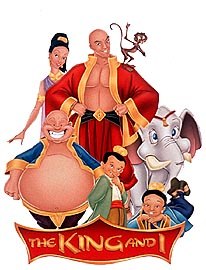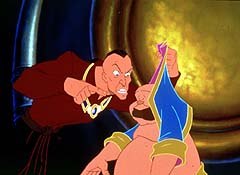While steering clear of true innovation, The King andI, does have some interesting twists and the same old, time tested andtrue score. Ilene Renee Gannaway reports.

When most people think of The King and I, one predominant image comes to mind -- that of the dashing Yul Brynner whisking the exquisite Deborah Kerr across a Siamese ballroom to the upbeat, romantic tune, "Shall We Dance?" It's been 43 years since the Rodgers and Hammerstein classic musical first graced the silver screen. And miraculously, neither Yul Brynner nor Deborah Kerr seem to have aged. The only marked change is that instead of being living, breathing human beings, they are now fully animated characters traipsing across 19th Century Siam's tenuous, political landscape in Warner Bros. newest animated feature. Like the stubborn King of Siam who struggles to uphold tradition while simultaneously breaking new cultural and scientific ground for his country, the creative team behind this film wrestles with imitation versus innovation. Though his subject is grand and epic, director Richard Rich (The Swan Princess) has a lot to live up to -- highly successful, prior incarnations of the time-honored musical, as well as the animated feature giants dominated largely by Disney. Unlike the King, Rich and his team ultimately choose to adhere to tradition rather than blaze new trails. While their film is by no means a watershed, it still proves satisfying in its sincerity. Getting to Know the Story The King and I tells the story of a young English widow who travels to Siam to teach Western ways to the royal children. In the original film, the King claims to have over 100 offspring, though we only meet a dozen or so. In the Rich film, that number has been drastically reduced to eight very charming tykes whom we first encounter in the warm-hearted sequence, "March of the Siamese Children." Those familiar with the 1956 film will notice an utter replication of this commanding yet playful scene with one exception. Instead of the imperial King carrying his shy, peanut-sized daughter to her siblings, he comically slides her across the shiny floor and precisely into place beside the other prince and princesses. It's a wonderful image that illustrates the King's humanity as well as his love for his children and shows the power of animation to exaggerate and heighten special moments. Shy, giggly, servant women roam freely through the palace, but no mention is made to their being the king's multifarious wives or the children's mothers. Apparently, Rich wants to preserve his G-rating while at the same time remaining sensitive to the realities of the Siamese royal court. The film largely pays lip service to any delicate issues -- delicate at least by Western standards -- especially the off-screen relationship between the King and his newest concubine, Tuptim, who is merely referred to as another servant girl. At first, the headstrong Anna and the equally strong-minded King clash. The King may espouse scientific progress and want to Europeanize his country in theory, but he cannot wrap his finger around the modern notions Anna advocates of freedom, individual will and even true love. However, he must reconcile these notions quickly if he is to avoid the disparaging label of barbarian by the British ambassador who wishes to make the `backward' Siam a protectorate of `civilized' England. Kralahome, the evil Siamese Prime Minister, is bent on facilitating the King's failure so that he may take over the country and ensure his interest in the ivory trade. Admittedly, the plot sounds a little too sophisticated and complex for the utterly exhausted, animated feature formula honed by Disney. According to this formula, you take a clear and simple story, dominate it with visuals, not dialogue, add a strong villain who proves a viable threat to a single protagonist, and fold in a few playful, animal sidekicks that deliver side-splitting antics to amuse younger audience member. Be sure to bake for 90 minutes. Rather than remake the live-action film shot by shot, Rich and screenwriters Jacqueline Feather and David Seidler have actually risen to the challenge and, for better or worse, created a film that follows the animation recipe step by step...well, almost. The animal sidekicks, Tuskers (an elephant) and Moonshee (a monkey) are cute but utterly forgettable, token props obviously included for merchandising purposes. The villain, Kralahome, is an uninteresting imitation of the Vizier in Disney's Aladdin. His agenda is overly-complicated and virtually impossible for youngsters to follow. Only Kralahome's tooth-losing henchman, Master Little (voiced by Saturday Night Live castmember Darrell Hammond), provides any real comic relief, spewing humorous one-liners such as, `Feel free to touch any sharp-pointed object you see.' Still one wonders how politically correct audiences are likely to judge him. He is, after all, a rude Asian caricature largely in the vein of Mickey Rooney's funny but highly offensive Mr. Yunioshi in Breakfast at Tiffany's.

Something Wonderfully Unfamiliar Where the filmmakers do succeed is in revising the secondary love story between Tuptim and the Crown Prince, and in newly-interpreting the showcase song, "Getting to Know You." In the original film, Tuptim arrives at the palace already in love with Lun Tha, the young man who brought her to Siam from Burma. They plot to run away together, but Tuptim is caught and Lun Tha drowned in the river. In this adaptation, Tuptim falls in love with the King's son who strongly resists change, believing that his home is the largest, most powerful country in the world. It isn't until he meets Tuptim and wishes to marry her, however, that his views alter. Suddenly Siam's fettered traditions, most notably the custom of arranged marriages and subservient harems, don't hold true for him anymore. In the earlier version, the Crown Prince has no real, tangible reason for transforming his beliefs. In this `90s version, love, not just Anna's teachings, motivate him to lead his country in a new direction, to realize his father's vision and to reconcile the moral conflicts which prevented the King from fully embracing change. Tuptim and the Crown Prince's `Romeo and Juliet' romance not only illustrates the need for change in Siam, it facilitates it. This is smart storytelling. The filmmakers are also thematically creative in the "Getting To Know You" musical sequence in which Anna and the children share their excitement over learning about each other. The 1956 film offered a charming but static scene in which Anna sings to the children in the classroom and then does a delightful fan dance with the children's mothers. As sweet as the number is, the song is only about the people in that room. In Rich's film, Anna and the children venture outside the palace walls for the very first time and take in all -- the good and the bad, the wealthy and the poor -- that is Siam. The song works on two levels. Anna and the kids learn about each other, and more importantly, they learn about the Siamese subjects who have previously been invisible to them. While the musical sequence is no stylistic breakthrough, it offers richly textured backgrounds, colorful props, and intricate dances that bring the Eastern culture alive. "Getting to Know You" does for Bangkok what "Do Re Me" does for Salzburg in The Sound of Music -- it makes the setting a character in itself.

Shall We Animate?
One of the benefits of animating The King and I is the ability to render landscape on an epic scale, to make external an essentially internal world. Both on stage and in live-action, the setting for this story is predominantly the King's palace, and though it is effulgent and colossal, the repetition of the interiors makes it feel paradoxically claustrophobic. This works well on a thematic level, but it still lacks the possibility of escape and freedom the bucolic landscape represents. Though a contemporary live-action film could certainly reproduce 19th Century Bangkok, animation offers a more unique interpretation. The lotus blossoms, the temples, and the rice fields are all brought into accentuated focus; they're not merely scene dressing. For all of its good qualities, The King and I ultimately does not give Disney a run for its money in the same way Fox's Anastasia did. The character designs are basically modeled after the original film cast, the character animation is uninspired, straight-to-video fare and most of the musical sequences, with the exception of "Getting to Know You," are not all that visually imaginative. Like the King of Siam, Rich Animation is trying very hard to become a contender among the animation superpowers, but they've got a long way to go. Still, we cannot deny they have rendered accessible for younger audiences a story with complex social, political and gender issues, plus Rodgers and Hammerstein's timeless songs. Naturally, the one thing that's virtually impossible to criticize is the music. Regardless of the film's strengths and weaknesses, everyone leaves the theater whistling a happy tune. Ilene Renee Gannaway is a freelance writer who served as Director of Development for Turner Feature Animation and as Manager of Development for Hanna-Barbera Cartoons. She is currently pursuing her Masters Degree in English Literature and unashamedly admits to loving Rodgers and Hammerstein musicals.







